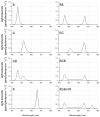Green Light Improves Photosystem Stoichiometry in Cucumber Seedlings (Cucumis sativus) Compared to Monochromatic Red Light
- PMID: 33919086
- PMCID: PMC8143185
- DOI: 10.3390/plants10050824
Green Light Improves Photosystem Stoichiometry in Cucumber Seedlings (Cucumis sativus) Compared to Monochromatic Red Light
Abstract
It has been shown that monochromatic red and blue light influence photosynthesis and morphology in cucumber. It is less clear how green light impacts photosynthetic performance or morphology, either alone or in concert with other wavelengths. In this study, cucumber (Cucumis sativus) was grown under monochromatic blue, green, and red light, dichromatic blue-green, red-blue, and red-green light, as well as light containing red, green, and blue wavelengths, with or without supplemental far-red light. Photosynthetic data collected under treatment spectra at light-limiting conditions showed that both red and green light enhance photosynthesis. However, photosynthetic data collected with a 90% red, 10% blue, 1000 µmol photons m-2 s-1, saturating light show significantly lower photosynthesis in the green, red, and red-green treatments, indicating a blue light enhancement due to photosystem stoichiometric differences. The red-green and green light treatments show improved photosynthetic capacity relative to red light, indicating partial remediation by green light. Despite a lower quantum efficiency and the lowest ambient photosynthesis levels, the monochromatic blue treatment produced among the tallest, most massive plants with the greatest leaf area and thickest stems.
Keywords: Cucumis sativus L. (cucumber); blue light; green light; intrinsic water use efficiency (iWUE); light-emitting diode (LED); morphology; photostationary state of phytochrome (PSS); photosynthesis; photosynthetic photon flux density (PPFD); red light; yield photon flux (YPF).
Conflict of interest statement
The authors declare no conflict of interest. The funders had no role in the design of the study; in the collection, analyses, or interpretation of data; in the writing of the manuscript, or in the decision to publish the results.
Figures






References
-
- Huché-Thélier L., Crespel L., Le Gourrierec J., Morel P., Sakr S., Leduc N. Light signaling and plant responses to blue and UV radiations—Perspectives for applications in horticulture. Environ. Exp. Bot. 2016;121:22–38. doi: 10.1016/j.envexpbot.2015.06.009. - DOI
-
- Massa G., Graham T., Haire T., Flemming II C., Gerard N., Wheeler R. Light-emitting diode light transmission through leaf tissue of seven different crops. HortScience. 2015;50:501–506. doi: 10.21273/HORTSCI.50.3.501. - DOI
LinkOut - more resources
Full Text Sources
Other Literature Sources

